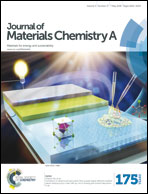Actual partial pressure of Se vapor in a closed selenization system: quantitative estimation and impact on solution-processed chalcogenide thin-film solar cells†
Abstract
One of the most important experimental factors in selenization, in which a precursor material is annealed at high temperature with Se vapor or gas to form chalcogenide light-absorbing layers, is the partial pressure of the Se vapor or gas (PSe). Although it is generally believed that the PSe should be sufficient to induce enhanced grain growth in the final film, the quantitative estimation of PSe has rarely been reported, and a detailed physical understanding of how the characteristics of absorber films and corresponding devices are affected by PSe is still far from clear. We performed a systematic study to address these PSe-related issues on solution processed CISe2 (CISe) thin films and solar cells. Based on a gas pressure equilibration model, we quantitatively estimated the actual PSe value and used this model to gain insight into how the initial experimental conditions of the Se level or background pressure influenced the actual PSe. It was found that the actual PSe varied significantly differently in an unexpected way: PSe did not vary linearly with the initial amount of Se and the trend of variation was significantly affected by the background pressure. The device parameter of the solution processed CISe solar cells that was primarily affected by PSe was the shunting, which is interpreted by the morphological differences of the absorber films grown under different PSe conditions.


 Please wait while we load your content...
Please wait while we load your content...